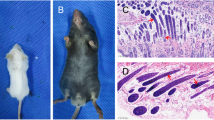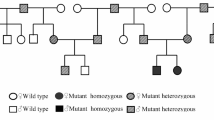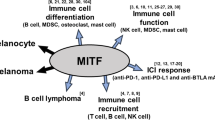Abstract
The microphthalmia-associated transcription factor (MITF) is a basic helix-loop-helix leucine zipper transcription factor, which regulates melanocyte development and the biosynthetic melanin pathway. A notable relationship has been described between non-truncating mutations of its basic domain and Tietz syndrome, which is characterized by albinoid-like hypopigmentation of the skin and hair, rather than the patchy depigmentation seen in Waardenburg syndrome, and severe hearing loss. Twelve patients with new or recurrent non-truncating mutations of the MITF basic domain from six families were enrolled in this study. We observed a wide range of phenotypes and some unexpected features. All the patients had blue irides and pigmentation abnormalities that ranged from diffuse hypopigmentation to Waardenburg-like patches. In addition, they showed congenital complete hearing loss, diffuse hypopigmentation of the skin, freckling and ocular abnormalities, more frequently than patients with MITF mutations outside the basic domain. In conclusion, the non-truncating mutations of the basic domain do not always lead to Tietz syndrome but rather to a large range of phenotypes. Sun-exposed freckles are interestingly observed more frequently in Asian populations. This variability argues for the possible interaction with modifier loci.
Similar content being viewed by others
Log in or create a free account to read this content
Gain free access to this article, as well as selected content from this journal and more on nature.com
or
Accession codes
References
Hershey CL, Fisher DE : Genomic analysis of the microphthalmia locus and identification of the MITF-J/Mitf-J isoform. Gene 2005; 347: 73–82.
Read AP, Newton VE : Waardenburg syndrome. J Med Genet 1997; 34: 656–665.
Pingault V, Ente D, Dastot-Le Moal F, Goossens M, Marlin S, Bondurand N : Review and update of mutations causing Waardenburg syndrome. Hum Mutat 2010; 31: 391–406.
Tietz W : A syndrome of deaf-mutism associated with albinism showing dominant autosomal inheritance. Am J Hum Genet 1963; 15: 259–264.
Amiel J, Watkin PM, Tassabehji M, Read AP, Winter RM : Mutation of the MITF gene in albinism-deafness syndrome (Tietz syndrome). Clin Dysmorphol 1998; 7: 17–20.
Smith SD, Kelley PM, Kenyon JB, Hoover D : Tietz syndrome (hypopigmentation/deafness) caused by mutation of MITF. J Med Genet 2000; 37: 446–448.
Tassabehji M, Newton VE, Liu XZ et al: The mutational spectrum in Waardenburg syndrome. Hum Mol Genet 1995; 4: 2131–2137.
Izumi K, Kohta T, Kimura Y et al: Tietz syndrome: unique phenotype specific to mutations of MITF nuclear localization signal. Clin Genet 2008; 74: 93–95.
Shigemura T, Shiohara M, Tanaka M, Takeuchi K, Koike K : Effect of the mutant microphthalmia-associated transcription factor found in Tietz syndrome on the in vitro development of mast cells. J Pediatr Hematol Oncol 2010; 32: 442–447.
Chiang PW, Spector E, McGregor TL : Evidence suggesting digenic inheritance of Waardenburg syndrome type II with ocular albinism. Am J Med Genet A 2009; 149A: 2739–2744.
Tassabehji M, Newton VE, Read AP : Waardenburg syndrome type 2 caused by mutations in the human microphthalmia (MITF) gene. Nat Genet 1994; 8: 251–255.
Niel F, Martin J, Dastot-Le Moal F et al: Rapid detection of CFTR gene rearrangements impacts on genetic counselling in cystic fibrosis. J Med Genet 2004; 41: e118.
Fuse N, Yasumoto K, Suzuki H, Takahashi K, Shibahara S : Identification of a melanocyte-type promoter of the microphthalmia-associated transcription factor gene. Biochem Biophys Res Commun 1996; 219: 702–707.
Lee M, Goodall J, Verastegui C, Ballotti R, Goding CR : Direct regulation of the microphthalmia promoter by Sox10 links Waardenburg-Shah syndrome (WS4)-associated hypopigmentation and deafness to WS2. J Biol Chem 2000; 275: 37978–37983.
Desmet FO, Hamroun D, Lalande M, Collod-Beroud G, Claustres M, Beroud C : Human Splicing Finder: an online bioinformatics tool to predict splicing signals. Nucleic Acids Res 2009; 37: e67.
Guex N, Peitsch MC : SWISS-MODEL and the Swiss-PdbViewer: an environment for comparative protein modeling. Electrophoresis 1997; 18: 2714–2723.
Chen H, Jiang L, Xie Z et al: Novel mutations of PAX3, MITF, and SOX10 genes in Chinese patients with type I or type II Waardenburg syndrome. Biochem Biophys Res Commun 2010; 397: 70–74.
Parraga A, Bellsolell L, Ferre-D’Amare AR, Burley SK : Co-crystal structure of sterol regulatory element binding protein 1a at 2.3 A resolution. Structure 1998; 6: 661–672.
Moore KJ : Insight into the microphthalmia gene. Trends Genet 1995; 11: 442–448.
Chen J, Yang SZ, Liu J et al: [Mutation screening of MITF gene in patients with Waardenburg syndrome type 2]. Yi Chuan 2008; 30: 433–438.
Bard LA : Heterogeneity in Waardenburg's syndrome. Report of a family with ocular albinism. Arch Ophthalmol 1978; 96: 1193–1198.
Morell R, Spritz RA, Ho L et al: Apparent digenic inheritance of Waardenburg syndrome type 2 (WS2) and autosomal recessive ocular albinism (AROA). Hum Mol Genet 1997; 6: 659–664.
Bastiaens M, ter Huurne J, Gruis N et al: The melanocortin-1-receptor gene is the major freckle gene. Hum Mol Genet 2001; 10: 1701–1708.
Gerstenblith MR, Goldstein AM, Fargnoli MC, Peris K, Landi MT : Comprehensive evaluation of allele frequency differences of MC1R variants across populations. Hum Mutat 2007; 28: 495–505.
Sulem P, Gudbjartsson DF, Stacey SN et al: Genetic determinants of hair, eye and skin pigmentation in Europeans. Nat Genet 2007; 39: 1443–1452.
Delleman JW, Hageman MJ : Ophthalmological findings in 34 patients with Waardenburg syndrome. J Pediatr Ophthalmol Strabismus 1978; 15: 341–345.
Schwarzbraun T, Ofner L, Gillessen-Kaesbach G et al: A new 3p interstitial deletion including the entire MITF gene causes a variation of Tietz/Waardenburg type IIA syndromes. Am J Med Genet A 2007; 143: 619–624.
Acknowledgements
We acknowledge the patients and families involved in this study as well as the contributions of Dr John Grigg (Ophthalmologist, Sydney, Australia), Dr Anne Besancon (Le Maillon Blanc, Hôpitaux universitaires de Strasbourg, France) and Anne Pelletier (CARGO, Strasbourg, France).
Author information
Authors and Affiliations
Corresponding author
Ethics declarations
Competing interests
The authors declare no conflict of interest.
Additional information
Supplementary Information accompanies the paper on European Journal of Human Genetics website
Supplementary information
Rights and permissions
About this article
Cite this article
Léger, S., Balguerie, X., Goldenberg, A. et al. Novel and recurrent non-truncating mutations of the MITF basic domain: genotypic and phenotypic variations in Waardenburg and Tietz syndromes. Eur J Hum Genet 20, 584–587 (2012). https://doi.org/10.1038/ejhg.2011.234
Received:
Revised:
Accepted:
Published:
Issue date:
DOI: https://doi.org/10.1038/ejhg.2011.234
Keywords
This article is cited by
-
Acetylation reprograms MITF target selectivity and residence time
Nature Communications (2023)
-
Expanding the phenotype of E318K (c.952G > A) MITF germline mutation carriers: case series and review of the literature
Hereditary Cancer in Clinical Practice (2021)
-
The Tietz syndrome associated with cardiac malformation: a case report with literature review
The Egyptian Journal of Otolaryngology (2021)
-
Waardenburg syndrome type 2A in a large Iranian family with a novel MITF gene mutation
BMC Medical Genomics (2021)
-
Four mutations in MITF, SOX10 and PAX3 genes were identified as genetic causes of waardenburg syndrome in four unrelated Iranian patients: case report
BMC Pediatrics (2021)



